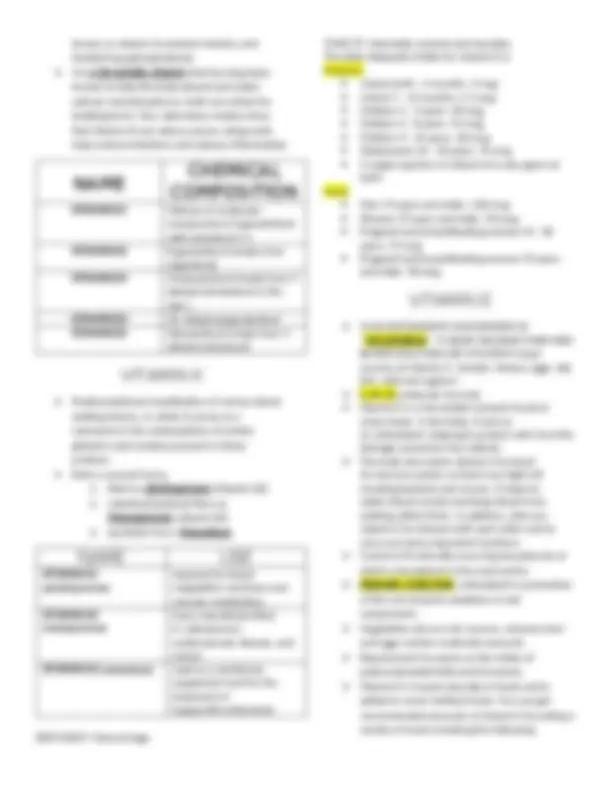





Study with the several resources on Docsity

Earn points by helping other students or get them with a premium plan


Prepare for your exams
Study with the several resources on Docsity

Earn points to download
Earn points by helping other students or get them with a premium plan
Community
Ask the community for help and clear up your study doubts
Discover the best universities in your country according to Docsity users
Free resources
Download our free guides on studying techniques, anxiety management strategies, and thesis advice from Docsity tutors
A comprehensive review of vitamins, including their types, functions, and deficiencies. It covers water-soluble and fat-soluble vitamins, B-vitamins, and vitamin A, C, and D. The document also discusses the routes of administration for insulin and its importance in regulating blood sugar levels. The information presented in this document is useful for students studying biochemistry, nutrition, and medicine.
Typology: Lecture notes
1 / 6

This page cannot be seen from the preview
Don't miss anything!




Water-soluble vitamins NON-B-COMPLEX: ASCORBIC ACID (Vitamin C) B-COMPLEX: THIAMINE (B1) RIBOFLAVIN (B2) NIACIN (B3) BIOTIN PANTOTHENIC PYRIDOXAL FOLIC ACID (B9) CYDNOCOBALAMINE (B12) PYRIDOXINE (B6) PYRIDOXAMINE Fat-soluble vitamins Vitamin A (Retinol, B-carotenes) Vitamin D (Cholecalciferol) Vitamin E (Tocopherol) Vitamin K (Phylloquinone, Menaquinone)
One carbon metabolism Inadequate serum levels can cause by alcoholism, folate, free-diet, and poor absorption etc. DEFICIENCY: Megaloblastic Anemia, Spina bifida, and anencephaly. COBALAMINE – B Two essential enzymatic reactions DEFICIENCY: Pernicious anemia PYRIDOXINE – B Pyridoxine, pyridoxal, and pyridoxamine are all derivatives of pyridine although they only differ in nature of functional group attached to their ring. Occurs primarily in plants. Pyridoxal and pyridoxamine – which is from animal DEFICIENCY: Peripheral Neuritis THIAMINE – B helps the body generate energy from nutrients. It is necessary for the growth, development and function of cells. DEFICIENCY: Wet beriberi; Dry Beriberi NIACIN (NICOTINIC ACID) – B Substituted pyridine derivative DEFICIENCY: Pellagra It is a disease which involves the skin The 3d’s which stand for:
**_1. Dermatitis
Is the major component of diet. INDANTILE: Vomiting ADULT: Dry skin, irritability
Due to chronic alcoholism. APATHY LOSS OF MEMORY ATAXIA Rhythmic to-and-fro motion.
build up on the walls of your blood vessels. RIBOFLAVIN – B Not associated with a major human disease, thus accompanies other vitamin deficiencies. DEFICIENCY: Dermatitis, Cheilosis and Glossitis.
Coenzyme in hydroxylation reactions Maintenance of normal connective tissues, as well as for wound healing. Facilitates absorption of dietary, iron from the intestine. Vitamin C benefits the body by holding cells together through collagen synthesis; collagen is a connective tissue that holds muscles, bones, and other tissues together. DEFICIENCY: Scurvy
Vision, reproduction, growth, and maintenance of epithelial tissues Primary alcohol containing a B-ionone ring with an unsaturated side chain found in animal tissues as a retinyl ester with long chain fatty acids. RETINAL Aldehyde derived from the oxidation of retinol Retinal and retinol can readily be interconverted. RETINOIC ACID Derived from the oxidation of retinal Cannot be reduced in the body, and therefore, cannot give rise to either retinal or retinol. B- CAROTENE Plant foods contain B-carotene, which can be oxidatively cleaved in the intestine to yield two molecules of retinal. Vitamin A excreted in the urine during acute infection. Vitamin A is used to prevent and treat xerophthalmia (unable to see in low light) and night blindness. Vitamin A is in a class of medications called an antioxidant. It is needed by the body to help with vision, reproduction, cell growth, and to support the immune system Vitamin A is mobilized from liver stores and transported in plasma as retinol bound to a specific transport protein, retinol-binding protein (RBP). Taking high doses of vitamin A supplements can cause liver damage. Combining high doses of vitamin, A supplements with other drugs that can damage the liver could increase the risk of liver disease. Orlistat (Alli, Xenical). This weight- loss drug can decrease the absorption of food sources of vitamin A. DEFICIENCY: Night blindness Xerophthalmia (dryness of the conjunctiva) Corneal ulceration > blindness Acne & Psoriasis TOXICITY: Hypervitaminoses A
ERGOCALCIFEROL – Vitamin D Vitamin D is essential for maintaining healthy bones and teeth. It also plays many other important roles in the body, including regulating inflammation and immune function. Vitamin D is essential for maintaining healthy bones and teeth. It also plays many other important roles in the body, including regulating inflammation and immune function. Vitamin D is indicated for use in the treatment of hypoparathyroidism, refractory rickets (also
Vegetable oils like wheat germ, sunflower, and safflower oils are among the best sources of vitamin E. Nuts, Green vegetables. Food companies add vitamin E to some breakfast cereals, fruit juices, margarines and spreads, and other foods. DEFICIENCY: almost entirely restricted to premature infants; in adults, usually associated with defective lipid absorption or transport TOXICITY: Least topic of the fat-soluble vitamins, and no toxicity has been observed at doses of 300 mg/day.
is needed for more than 300 biochemical reactions in the body. It helps to maintain normal nerve and muscle function, supports a healthy immune system, keeps the heartbeat steady, and helps bones remain strong. Magnesium plays an important role in the regulation of several bodily processes including: blood pressure, insulin metabolism, muscular contraction, vasomotor tone, cardiac excitability, nerve transmission neuromuscular conduction.
is a prominent molecule that is involved in many biochemical processes throughout the body. It is an essential element for proper cardiac function, the structural integrity of bone, and muscular contraction and acts as an enzymatic signal in biochemical pathways. Calcium is a major component of the bone matrix and teeth. Additionally, various calcium channels are involved in: blood vessel constriction and relaxation muscle contraction, nerve action potentials cardiac electrophysiology. Calcium and magnesium work together to support bone health and other bodily functions. Magnesium is needed for calcium absorption. Because magnesium suppresses parathyroid hormone and stimulates calcitonin, it helps deposit calcium into our bones, preventing osteoporosis.
TRIACYLGLYCEROL (triglycerides) are trysters of glycerol and long-chain carboxylic acids called fatty acids. Most of the triacylglycerols are stored in the adipose tissue Simple triacylglycerols have three identical fatty acids Mixed triacylglycerols have two or three different fatty acids. Triacylglycerols are the major energy store and the major dietary lipid in humans. They are insoluble in water and are stored in specialized adipose (fat) cells. Triacylglycerols are synthesized from fatty acyl CoAs and glycerol 3-phosphate. Physical properties depend on the fatty acid components. Melting point increases as the number of carbons in its hydrocarbon chains increases and as the number double bonds decreases. Oils : Triglycerides rich in unsaturated fatty acids are generally liquid at room. Fats : Triglycerides rich in saturated fatty acids are generally semisolids or solids at room temperature. Chemical properties of triacylglycerol. Triglycerides have typical ester and alkene chemical properties as they are composed of these two groups Saponification : replace H with salt from a strong base. Hydrolysis : produces the fatty acids and glycerol, a reverse of formation. Hydrogenation : saturates the double double- bonds.
Insulin is a hormone created by your pancreas that controls the amount of glucose in your bloodstream at any given moment. It also helps store glucose in your liver, fat, and
muscles. Finally, it regulates your body’s metabolism of carbohydrates, fats, and proteins. When we eat, the blood glucose levels rise, and this leads a typical person’s pancreas to release insulin, so that the sugar can be stored as energy for later use. Without that pancreatic ability, as a person with either type 1 diabetes or advanced type 2 diabetes, your blood sugar levels may rise dangerously high, or drop too low.
If your body doesn’t make insulin or doesn’t make enough, you are eventually diagnosed with type 1 diabetes. It used to be called juvenile diabetes, but new estimates show that as many as half of people with type 1 diabetes are not diagnosed until adulthood. On the other hand, if your body doesn’t use insulin properly, you have type 2 diabetes.
Depending on different circumstances it can: Be injected subcutaneously (in the skin) via an insulin syringe, pre-filled pen device or insulin pen For certain patients with type 1 diabetes, be delivered as an insulin infusion via a wearable personal insulin pump. Be administered through an intravenous insulin infusion Insulin shots are most effective when you take them so that insulin goes to work when glucose from your food starts to enter your blood. For example, regular insulin works best if you take it 30 minutes before you eat.
Glucagon is a hormone that your pancreas makes to help regulate your blood glucose (sugar) levels. Glucagon increases your blood sugar level and prevents it from dropping too low, whereas insulin, another hormone, decreases blood sugar levels. Your body normally carefully regulates your blood glucose (sugar) primarily with the hormone glucagon and insulin. When your blood glucose levels trend lower or fall too low (hypoglycemia), your pancreas releases more glucagon. Glucagon helps blood glucose levels rise back up in multiple ways, including:
Glucagon and insulin are both important hormones that play essential roles in regulating our blood glucose (sugar). Both hormones come from the pancreas — alpha cells in your pancreas make and release glucagon, and beta cells in your pancreas make and release insulin. The difference is in how these hormones contribute to blood sugar regulation. Glucagon increases blood sugar levels, whereas insulin decreases blood sugar levels. If your pancreas doesn’t make enough insulin or your body doesn’t use it properly, you can have high blood sugar (hyperglycemia), which leads to diabetes.
sometimes called “good” cholesterol, absorbs cholesterol in the blood and carries it back to the liver. The liver then flushes it from the body. High levels of HDL cholesterol can lower your risk for heart disease and stroke.
is often called the “bad” cholesterol because it collects in the walls of your blood vessels, raising your chances of health problems like a heart attack or stroke. But cholesterol isn't all dangerous. Your body needs it to protect its nerves and make healthy cells and hormones.
HDL is considered “good” cholesterol, while LDL is considered “bad.” This is because HDL carries cholesterol to your liver, where it can be removed from